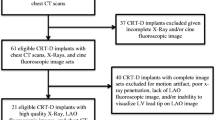Abstract
Background
Optimal left ventricular (LV) lead position is thought to be a major predictor of response in patients undergoing cardiac resynchronization therapy (CRT). While the post-implant posterior–anterior (PA) and lateral chest X-ray (CXR) is commonly used to determine the position of the LV lead, the accuracy to which the CXR can correctly localize the LV lead is unknown.
Methods
We collected data on 47 consecutive patients (mean age 64 years, 60% men and LV ejection fraction 23%, 49% ischemic cardiomyopathy) that underwent CRT between 2004 and 2007, who had both a post-implant CXR as well as a contrast-enhanced multi-detector computed tomography (MDCT) of the chest for any reason. The positions of the LV lead on CXR and MDCT were interpreted in a blinded fashion, independent of each other. The accuracy of the CXR in localizing various LV lead positions, with MDCT as the gold standard, was recorded.
Results
On CXR, the LV lead tip position was as follows: basal (4%), mid-ventricular (66%), and apical (30%) and anterior (2%), lateral (34%), and posterior (64%). On MDCT, the LV tip position was: basal (28%), mid-ventricular (60%), and apical (13%) and anterior (13%), lateral (19%), and posterior (68%). Compared to the MDCT gold standard, the percentage of LV lead positions the CXR correctly classified correctly were: 100% basal, 39% mid-ventricular, and 29% apical and 0% anterior, 12% lateral, and 77% posterior. Taking both PA and lateral views into consideration, the LV lead position was misclassified by CXR in 62% cases.
Conclusion
Using MDCT as a gold standard, the routine post-implant CXR performs very modestly in terms of accurate LV lead positioning.






Similar content being viewed by others
References
Bristow, M. R., Saxon, L. A., Boehmer, J., et al. (2004). Cardiac-resynchronization therapy with or without an implantable defibrillator in advanced chronic heart failure. The New England Journal of Medicine, 350, 2140–2150.
Abraham, W. T., Fisher, W. G., Smith, A. L., et al. (2002). Cardiac resynchronization in chronic heart failure. The New England Journal of Medicine, 346, 1845–1853.
Cleland, J. G., Daubert, J. C., Erdmann, E., et al. (2005). The effect of cardiac resynchronization on morbidity and mortality in heart failure. The New England Journal of Medicine, 352, 1539–1549.
Bax, J. J., Ansalone, G., Breithardt, O. A., et al. (2004). Echocardiographic evaluation of cardiac resynchronization therapy: ready for routine clinical use? A critical appraisal. Journal of the American College of Cardiology, 44, 1–9.
Bax, J. J., Marwick, T. H., Molhoek, S. G., et al. (2003). Left ventricular dyssynchrony predicts benefit of cardiac resynchronization therapy in patients with end-stage heart failure before pacemaker implantation. The American Journal of Cardiology, 92, 1238–1240.
Spragg, D. D., Dong, J., Fetics, B. J., et al. (2010). Optimal left ventricular endocardial pacing sites for cardiac resynchronization therapy in patients with ischemic cardiomyopathy. Journal of the American College of Cardiology, 56, 774–781.
Wilton, S. B., Shibata, M. A., Sondergaard, R., Cowan, K., Semeniuk, L., & Exner, D. V. (2008). Relationship between left ventricular lead position using a simple radiographic classification scheme and long-term outcome with resynchronization therapy. Journal of Interventional Cardiac Electrophysiology, 23, 219–227.
Butter, C., Auricchio, A., Stellbrink, C., et al. (2001). Effect of resynchronization therapy stimulation site on the systolic function of heart failure patients. Circulation, 104, 3026–3029.
Ypenburg, C., van Bommel, R. J., Delgado, V., et al. (2008). Optimal left ventricular lead position predicts reverse remodeling and survival after cardiac resynchronization therapy. Journal of the American College of Cardiology, 52, 1402–1409.
Merchant, F. M., Heist, E. K., McCarty, D., et al. (2010). Impact of segmental left ventricle lead position on cardiac resynchronization therapy outcomes. Heart Rhythm, 7, 639–644.
Gold, M. R., Auricchio, A., Hummel, J. D., et al. (2005). Comparison of stimulation sites within left ventricular veins on the acute hemodynamic effects of cardiac resynchronization therapy. Heart Rhythm, 2, 376–381.
Saxon, L. A., Olshansky, B., Volosin, K., et al. (2009). Influence of left ventricular lead location on outcomes in the COMPANION study. Journal of Cardiovascular Electrophysiology, 20, 764–768.
Becker, M., Franke, A., Breithardt, O. A., et al. (2007). Impact of left ventricular lead position on the efficacy of cardiac resynchronisation therapy: a two-dimensional strain echocardiography study. Heart, 93, 1197–1203.
Becker, M., Kramann, R., Franke, A., et al. (2007). Impact of left ventricular lead position in cardiac resynchronization therapy on left ventricular remodelling. A circumferential strain analysis based on 2D echocardiography. European Heart Journal, 28, 1211–1220.
Mullens, W., Grimm, R. A., Verga, T., et al. (2009). Insights from a cardiac resynchronization optimization clinic as part of a heart failure disease management program. Journal of the American College of Cardiology, 53, 765–773.
Kumar, P., Blendea, D., Nandigam, V., Moore, S. A., Heist, E. K., & Singh, J. P. (2010). Assessment of the post-implant final left ventricular lead position: a comparative study between radiographic and angiographic modalities. J Interv Card Electrophysiol, 29, 17–22.
Taylor, A. J., Cerqueira, M., Hodgson, J. M., ACCF/SCCT/ACR/AHA/ASE/ASNC/NASCI/SCAI/SCMR, et al. (2010). Appropriate use criteria for cardiac computed tomography: a report of the American College of cardiology foundation appropriate use criteria task force, the society of cardiovascular computed tomography, the American College of Radiology, the American Heart Association, the American Society of Echocardiography, the American Society of Nuclear Cardiology, the North American society for cardiovascular imaging, the society for cardiovascular angiography and interventions, and the society for cardiovascular magnetic resonance. Circulation, 122, e525–e555.
Halliburton, S. S., & Schoenhagen, P. (2010). Cardiovascular imaging with computed tomography: responsible steps to balancing diagnostic yield and radiation exposure. JACC Cardiovascular Imaging, 3, 536–540.
Conflicts of interest
None except for the following: Bruce L. Wilkoff, Major research: Medtronic, St. Jude, Boston Scientific.
Author information
Authors and Affiliations
Corresponding author
Rights and permissions
About this article
Cite this article
Rickard, J., Ingelmo, C., Sraow, D. et al. Chest radiography is a poor predictor of left ventricular lead position in patients undergoing cardiac resynchronization therapy: comparison with multidetector computed tomography. J Interv Card Electrophysiol 32, 59–65 (2011). https://doi.org/10.1007/s10840-011-9586-9
Received:
Accepted:
Published:
Issue Date:
DOI: https://doi.org/10.1007/s10840-011-9586-9




